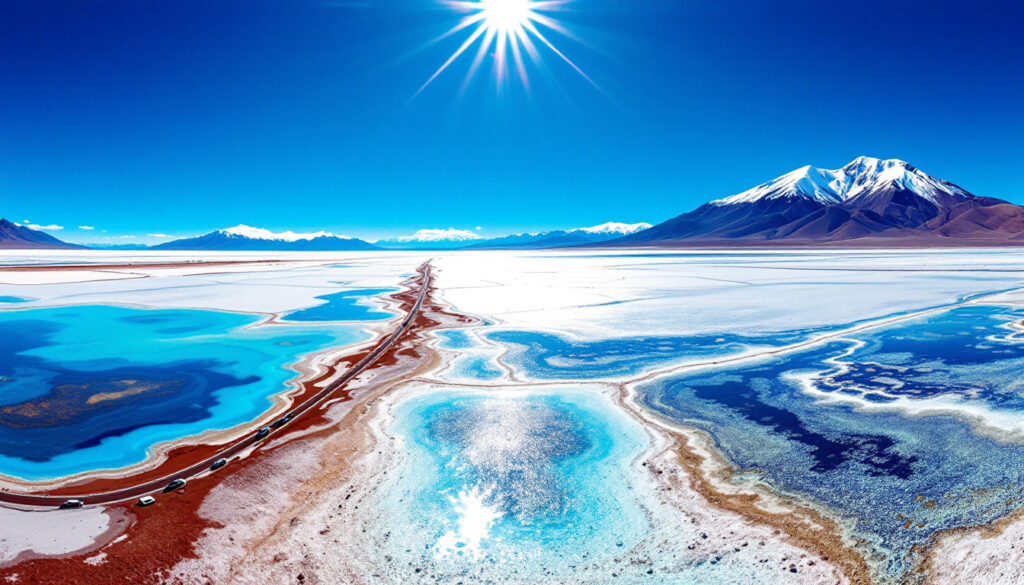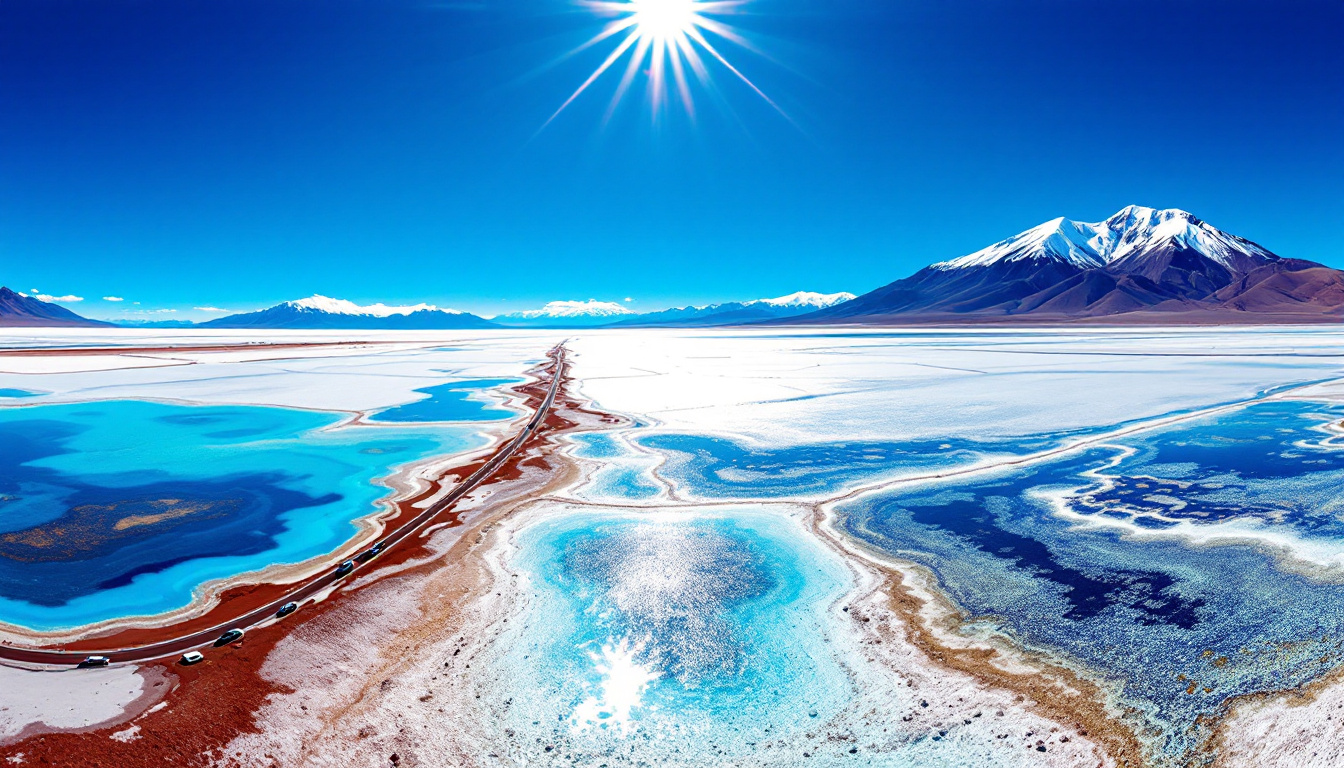Why is South American Lithium Investment Surging Despite Price Declines?
South America's lithium triangle continues to attract major investment despite lithium prices hitting multi-year lows, with mining giants clearly positioning for long-term growth in the critical battery metal sector. According to Wood Mackenzie analysis, while the current market faces significant oversupply, projections indicate a potential supply deficit emerging by the early 2030s, driving strategic investments today.
Global mining companies are leveraging the current price weakness to secure high-quality resources at favorable valuations. Spodumene concentrate prices have plummeted to approximately US$625/tonne—their lowest level since February 2021 and a dramatic 87% decline from peak prices above US$5,000/tonne in 2022.
Despite this pricing environment, major players like Rio Tinto have committed substantial capital to South American lithium investment, signaling strong confidence in the region's long-term fundamentals and cost advantages over competing jurisdictions.
What Makes South America a Lithium Investment Hotspot?
The Strategic Lithium Triangle
The lithium triangle spanning Argentina, Chile, and Bolivia contains approximately 58% of the world's lithium resources, primarily in salt flat brines. This unparalleled concentration of resources gives the region significant strategic importance in global supply chains.
The region's brine-based resources offer a compelling economic advantage with production costs typically 30-40% lower than hard rock operations in Australia and elsewhere. This cost differential becomes particularly significant during price downturns, explaining the continued investment despite challenging market conditions.
Most South American lithium is found in subsurface brines beneath salt flats (salars), with the Salar de Atacama in Chile and Argentina Lithium Brine Insights from the Salar del Hombre Muerto representing some of the world's highest-grade commercial lithium brine deposits.
Favorable Geological Conditions
South America's lithium-rich salt flats offer distinct advantages for extraction that hard rock mining cannot match. The region's exceptionally high evaporation rates—particularly in Chile's Atacama Desert, which experiences evaporation rates of approximately 3,500mm per year—create ideal conditions for cost-effective brine operations.
The concentration levels of lithium in South American brines frequently exceed 1,000 parts per million, significantly higher than most competing jurisdictions. This concentration advantage, combined with natural solar evaporation processes, enables production costs often ranging between $3,500-5,000 per tonne of lithium carbonate equivalent (LCE), compared to Australian hard rock costs of $5,000-6,500 per tonne.
"The geological conditions in South America's lithium triangle are truly unique globally," notes Dr. Mark King, hydrogeologist for American Salars Lithium. "The combination of high-grade brines, exceptional evaporation rates, and minimal rainfall creates optimal conditions for traditional brine operations."
Growing Regional EV Demand
According to International Energy Agency data, Latin America has emerged as a significant growth center for electric vehicle adoption, with EV sales surging by more than 60% across the region in 2023. This local demand growth complements the export-oriented production model that has historically characterized South American lithium operations.
Brazil, the region's largest automotive market, has implemented new tax incentives for electric vehicle manufacturers, while Chile has established ambitious electrification targets for public transportation. These regional demand drivers create additional market security for lithium producers beyond traditional export markets in Asia and Europe.
How Are Major Mining Companies Investing in South American Lithium?
Rio Tinto's Strategic Chilean Partnership
Rio Tinto recently committed $400 million to a joint venture with Chile's state-owned Codelco to develop a high-grade lithium project in the Salar de Maricunga. This landmark deal represents a significant shift in Chile's approach to lithium development, moving from a restrictive concession model toward strategic partnerships with major international miners.
The deal includes:
- $350 million in initial funding
- $500 million toward construction costs (contingent on project advancement)
- An additional $50 million if the project delivers first lithium by 2030
This Chilean investment follows Rio Tinto's $10 billion acquisition of Allkem and its $2.5 billion investment in the 60,000-tonne-per-annum Rincon lithium carbonate operation in Argentina. The aggressive investment strategy positions Rio Tinto to become what Benchmark Mineral Intelligence projects will be the world's second-largest lithium producer by 2035, behind only Albemarle.
Pilbara Minerals' Brazilian Expansion
Australia-based Pilbara Minerals has expanded beyond its home market into Brazil with its acquisition of Latin Resources and the Salinas project. The move highlights the growing recognition of Brazil's potential as an emerging lithium jurisdiction outside the traditional "lithium triangle" countries.
CEO Dale Henderson emphasized the compelling economics of Brazilian development:
"It's a fantastic proposition, which is frankly hard to beat globally. We considered opportunities in our backyard. Brazil just stacked up on every dimension."
This assessment underscores the comparative economic advantages of South American lithium development versus traditional mining regions. Brazil's combination of high-grade pegmatites, established mining infrastructure, and supportive regulatory environment has increasingly attracted international investment, despite being less established than the brine operations of Argentina and Chile.
What's Driving Investment Despite Current Market Conditions?
Long-Term Supply-Demand Fundamentals
According to detailed modeling from Wood Mackenzie, while the lithium market faces significant oversupply through 2027, the situation is projected to reverse dramatically by the early 2030s with potential supply deficits emerging. This long-term view explains why major miners are positioning aggressively today despite near-term pricing challenges.
The current market conditions represent a classic commodity cycle pattern: price spikes (2021-2022) triggered supply expansion, leading to the current oversupply and price correction. However, the projected exponential growth in electric vehicle production—with forecasts suggesting EVs could represent over 60% of new vehicle sales globally by 2035—will drive substantial lithium demand growth in the coming decade.
Current Price Environment
The lithium market has experienced extreme volatility over the past three years. Spodumene concentrate prices have fallen to approximately US$625/tonne—their lowest level since February 2021. This represents a dramatic decline from peak prices above US$5,000/tonne in 2022.
This pricing environment has particularly challenged higher-cost producers, including many Australia Lithium Innovations and hard rock operations, while South American brine producers with lower operating costs have demonstrated greater resilience. The current market oversupply is estimated at approximately 10,000-30,000 tonnes of lithium carbonate equivalent, representing roughly 1-3% of global production.
Strategic Positioning by Major Players
Nick Horsley, CEO of American Salars Lithium, notes that market rebalancing could occur more rapidly than many analysts project:
"The current surplus of 10,000-30,000 tonnes of lithium carbonate globally could be eliminated more quickly than expected if even one major hard rock mine ceases production, potentially bringing supply and demand back into balance as early as 2026."
This perspective highlights the relatively thin margins between surplus and deficit in the lithium market, despite the dramatic price corrections. Major mining companies with strong balance sheets can weather the current downturn while positioning strategically for the next market upturn.
Which Junior Companies Are Active in South American Lithium?
Brazilian Exploration Focus
Several junior companies are targeting Brazil's emerging pegmatite districts, which offer hard rock lithium potential complementary to the brine resources of the traditional lithium triangle. American Salars Lithium's Jaguaribe project in Ceará state has reported high-grade results from lithium-caesium-tantalum pegmatites, with lithium oxide grades reaching up to 3.72%.
Brazil's Borborema Pegmatite Province has emerged as a particular focus for exploration, with companies including Oceana Lithium raising capital ($667,000 in recent fundraising) to advance projects in the region. The proximity to existing infrastructure and supportive government policies have enhanced the attractiveness of Brazilian lithium exploration despite the challenging price environment.
Multi-Mineral Potential
Many South American lithium projects offer additional value through associated minerals, enhancing their economic viability. The Jaguaribe Project, for example, contains multiple lithium-bearing minerals (lepidolite, spodumene, and amblygonite) alongside rare earths, tantalum, niobium, and tin.
This multi-mineral potential creates revenue diversification opportunities not typically available in brine operations, which generally produce lithium as their primary or sole product. For junior companies operating with limited capital, this diversification can significantly improve project economics and decrease dependency on volatile lithium prices.
Argentine Brine Projects
Junior companies are also targeting Argentina's lithium salars, leveraging the country's more open investment environment compared to Chile's historically restrictive approach. American Salars holds 13,880 hectares of brine-prospective salar tenure at the Pocitos project and has recently appointed hydrogeologist Dr. Mark King to steer its exploration efforts.
Argentina has established itself as particularly welcoming to foreign investment in lithium, with provincial governments actively promoting development. This contrasts with Chile's historically more restrictive approach and Bolivia's state-led development model, making Argentina an attractive entry point for many junior companies seeking South American lithium exposure.
What Are the Market Implications for Lithium Investment?
Supply-Demand Balance Projections
The current lithium market oversupply is expected to peak in 2027 before potentially shifting to deficit by the early 2030s. This projected cycle is influencing investment strategies across the sector, with well-capitalized companies using the downturn to secure assets at favorable valuations.
The long-term demand drivers remain compelling. According to International Energy Agency projections, electric vehicle production could require more than 3 million tonnes of lithium carbonate equivalent annually by 2035—more than five times current global production levels. This demand projection underpins the strategic investments being made today despite near-term price weakness.
Potential for Accelerated Market Rebalancing
Industry analysts suggest that the current 10,000-30,000 tonne lithium carbonate surplus globally represents a relatively thin buffer. This surplus could be eliminated more quickly than expected if even one major hard rock mine ceases production due to economic challenges, potentially bringing supply and demand back into balance as early as 2026.
This market sensitivity highlights the relatively precarious nature of the current oversupply, despite dramatic price declines. Companies with strong balance sheets can maintain production through the downturn, while higher-cost producers may be forced to curtail operations, potentially accelerating market rebalancing.
Strategic Positioning for Next Upturn
Companies are increasingly focused on developing early-stage lithium projects that could enter production during the next market upturn, with particular emphasis on South American assets that offer cost advantages. The typical 3-5 year development timeline for new lithium projects means decisions made today will determine production capacity available during the projected supply deficit of the early 2030s.
This long-term strategic thinking explains why major mining companies continue to invest despite challenging near-term market conditions. Their investment horizons typically span decades rather than quarters, allowing them to leverage current price weakness to build positions in high-quality assets.
How Does South American Lithium Compare to Other Regions?
Cost Advantages vs. Australian Operations
South American brine operations typically offer substantially lower production costs than Australian hard rock mines. Industry analysis indicates brine operations can produce lithium carbonate at costs between $3,500-5,000 per tonne, compared to hard rock operations' costs of $5,000-6,500 per tonne.
This cost differential becomes particularly significant during price downturns, explaining the continued investment in South American projects despite current market conditions. Brine operations also typically have lower carbon footprints than energy-intensive hard rock mining and processing, potentially offering additional advantages as carbon pricing mechanisms expand globally.
Geopolitical Considerations
South America offers a potential alternative supply source to Chinese-dominated processing and Australian hard rock mining, creating strategic diversification opportunities for battery manufacturers and automakers. According to U.S. Department of Energy assessments, China currently controls approximately 60% of global lithium refining capacity, creating supply chain vulnerability for Western manufacturers.
This geopolitical dimension has increased interest in South American lithium development, particularly from North American and European automakers seeking to reduce dependency on Chinese supply chains. Recent policy initiatives in the United States and European Union have specifically incentivized sourcing from "friendly" jurisdictions, potentially benefiting South American producers.
Infrastructure and Development Challenges
While South American projects offer cost advantages, they often face infrastructure challenges and longer development timelines compared to expansions at existing operations in Australia or North America. Many high-potential brine projects are located in remote areas with limited existing infrastructure, requiring substantial capital investment beyond the direct extraction facilities.
Water access represents a particular challenge for many South American lithium projects, especially in Chile's Atacama region. According to UNESCO studies, brine extraction has raised concerns about impacts on fragile desert ecosystems and indigenous communities. Companies increasingly implement water recycling technologies and community benefit agreements to address these concerns.
What's the Outlook for South American Lithium Investment?
Continued Major Player Involvement
Major mining companies are likely to continue strategic investments in South American lithium assets, viewing current price weakness as an opportunity to secure high-quality resources at favorable valuations. Companies with strong balance sheets can absorb near-term losses while positioning for the projected supply deficit of the early 2030s.
The current investment pattern resembles previous commodity cycles where major mining companies used market downturns to acquire assets at favorable valuations before market recoveries. Rio Tinto's aggressive lithium expansion strategy, including its Chilean joint venture with Codelco and Argentine Rincon project, exemplifies this approach.
Consolidation Opportunities
The challenging price environment has created consolidation opportunities as junior companies with quality assets but limited funding seek partnerships with larger, well-capitalized players. Recent examples include Alpha Lithium's acquisition by Tecpetrol and Pilbara Minerals' acquisition of Latin Resources' Brazilian assets.
This consolidation trend is likely to accelerate if lithium prices remain depressed through 2025-2026, as projected by many analysts. Junior companies face particular challenges in raising capital during commodity downturns, creating opportunities for strategic acquisitions by major mining companies and well-funded mid-tier producers.
Production Timeline Considerations
Most new South American lithium projects will take 3-5 years to reach production, potentially aligning with projected market recovery in the late 2020s and early 2030s. This timeline includes permitting, construction, and the particularly lengthy commissioning process often required for brine operations.
The extended development timelines for South American projects mean that investment decisions made today will influence supply availability during the projected deficit period of the early 2030s. Companies delaying investment due to current market conditions may miss the opportunity to bring production online during the next pricing upturn.
FAQ: South American Lithium Investment
How do lithium brine operations differ from hard rock mining?
Lithium brine operations extract lithium from salt-rich groundwater through evaporation and processing, while hard rock mining involves traditional mining of lithium-bearing minerals like spodumene. Brine operations typically have lower operating costs but higher capital requirements and longer development timelines.
Brine extraction involves pumping lithium-rich groundwater into large evaporation ponds, where solar evaporation concentrates the solution over 12-18 months. The concentrated brine then undergoes chemical processing to produce lithium carbonate or hydroxide. Hard rock mining, by contrast, involves conventional drilling, blasting, and crushing, followed by concentration and chemical processing of spodumene or other lithium-bearing minerals.
Which countries make up South America's "lithium triangle"?
The lithium triangle consists of Argentina, Chile, and Bolivia, which together hold more than half of the world's known lithium resources. Each country offers distinct advantages and challenges:
- Chile: Highest-grade resources and most established production, but more restrictive regulatory environment
- Argentina: More open to foreign investment with substantial undeveloped resources
- Bolivia: Largest potential resources but historically restricted foreign investment
Brazil, while not part of the traditional lithium triangle, has emerged as an increasingly important player with significant hard rock (pegmatite) lithium resources.
Why are major miners investing during a price downturn?
Major mining companies operate on decade-long investment horizons and view current price weakness as an opportunity to secure high-quality resources at lower valuations, positioning for projected supply deficits in the 2030s.
This countercyclical investment approach has historically proven successful in other commodity sectors, allowing companies to acquire and develop assets at lower costs during downturns and capture maximum value during subsequent market recoveries. For lithium specifically, the projected gap between current prices and long-term demand fundamentals creates a compelling strategic opportunity for well-capitalized players.
What environmental concerns exist for South American lithium production?
Lithium brine operations consume significant water in often arid regions, raising concerns about impacts on local communities and ecosystems. According to UNESCO studies, brine extraction in Chile's Atacama region has potentially contributed to declining water tables and ecosystem changes.
Companies are increasingly implementing water recycling technologies and community benefit agreements to address these concerns. New technologies, including direct lithium extraction (DLE) methods, promise to reduce water consumption by up to 90% compared to traditional evaporation methods, though these technologies remain largely unproven at commercial scale in South American conditions.
How
Ready to Spot the Next Major Mineral Discovery?
Stay ahead of the market with Discovery Alert's proprietary Discovery IQ model, which instantly identifies significant ASX mineral discoveries and transforms complex data into actionable investment insights. Explore our dedicated discoveries page to understand how major mineral discoveries have historically generated substantial returns, and begin your 30-day free trial today.




